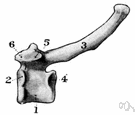tubercle
Also found in: Thesaurus, Medical, Encyclopedia, Wikipedia.
tu·ber·cle
(to͞o′bər-kəl, tyo͞o′-)n.
1. A small rounded projecting part or outgrowth, such as a wartlike excrescence on the roots of some leguminous plants or a knoblike process in the skin or on a bone.
2. Medicine A nodule or swelling, especially a mass of lymphocytes and epithelioid cells forming the characteristic lesion of tuberculosis.
[Latin tūberculum, diminutive of tūber, lump; see tuber.]
American Heritage® Dictionary of the English Language, Fifth Edition. Copyright © 2016 by Houghton Mifflin Harcourt Publishing Company. Published by Houghton Mifflin Harcourt Publishing Company. All rights reserved.
tubercle
(ˈtjuːbəkəl) ortuberculum
n
1. (Botany) any small rounded nodule or elevation, esp on the skin, on a bone, or on a plant
2. (Pathology) any small rounded pathological lesion of the tissues, esp one characteristic of tuberculosis
[C16: from Latin tūberculum a little swelling, diminutive of tuber]
Collins English Dictionary – Complete and Unabridged, 12th Edition 2014 © HarperCollins Publishers 1991, 1994, 1998, 2000, 2003, 2006, 2007, 2009, 2011, 2014
tu•ber•cle
(ˈtu bər kəl, ˈtyu-)n.
1. a small rounded projection or excrescence, as on a bone or on the surface of the body.
2.
a. a small, firm, rounded nodule or swelling.
b. such a swelling as the characteristic lesion of tuberculosis.
3. a tuberlike swelling or nodule on a plant.
Random House Kernerman Webster's College Dictionary, © 2010 K Dictionaries Ltd. Copyright 2005, 1997, 1991 by Random House, Inc. All rights reserved.
tu·ber·cle
(to͞o′bər-kəl) A small rounded projection or swelling, as on the roots of legumes or on skin or a bone.
The American Heritage® Student Science Dictionary, Second Edition. Copyright © 2014 by Houghton Mifflin Harcourt Publishing Company. Published by Houghton Mifflin Harcourt Publishing Company. All rights reserved.
ThesaurusAntonymsRelated WordsSynonymsLegend:
Switch to new thesaurus
| Noun | 1. |  tubercle - a swelling that is the characteristic lesion of tuberculosis tubercle - a swelling that is the characteristic lesion of tuberculosislesion - any localized abnormal structural change in a bodily part |
| 2. |  tubercle - small rounded wartlike protuberance on a plant tubercle - small rounded wartlike protuberance on a plantplant process, enation - a natural projection or outgrowth from a plant body or organ | |
| 3. |  tubercle - a protuberance on a bone especially for attachment of a muscle or ligament tubercle - a protuberance on a bone especially for attachment of a muscle or ligamentdeltoid eminence, deltoid tuberosity - a bump on the outside of the humerus where the deltoid muscle attaches |
Based on WordNet 3.0, Farlex clipart collection. © 2003-2012 Princeton University, Farlex Inc.
Translations
Collins Spanish Dictionary - Complete and Unabridged 8th Edition 2005 © William Collins Sons & Co. Ltd. 1971, 1988 © HarperCollins Publishers 1992, 1993, 1996, 1997, 2000, 2003, 2005
Collins German Dictionary – Complete and Unabridged 7th Edition 2005. © William Collins Sons & Co. Ltd. 1980 © HarperCollins Publishers 1991, 1997, 1999, 2004, 2005, 2007
tu·ber·cle
n. tubérculo.
1. nódulo pequeño;
2. pequeña prominencia de un hueso;
3. lesión producida por el bacilo de la tuberculosis.
English-Spanish Medical Dictionary © Farlex 2012